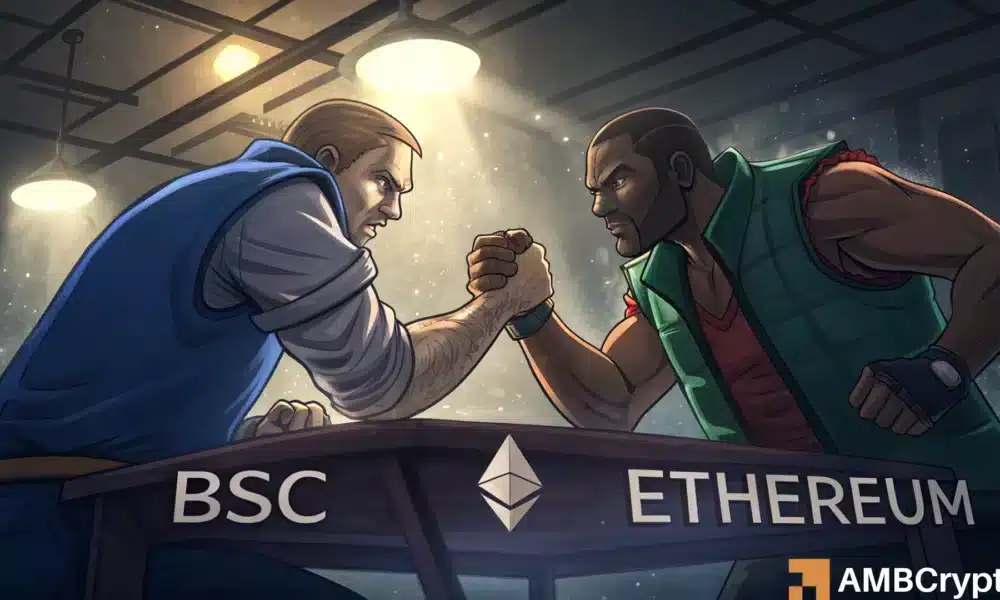BNB Chain vs. Ethereum: Analyzing Block Performance and On-Chain Activity
As the blockchain landscape evolves and expands within mainstream finance, Layer-1 chains are enhancing their protocols to position themselves as the next Web3 leaders. Recently, BNB Chain (BSC) has made headlines by producing an impressive 115,200 blocks per day, significantly outpacing Ethereum, which is projected to generate only 14,400 blocks daily following its anticipated upgrades. This remarkable difference raises questions about the implications of BSC’s performance on its long-term impact in the DeFi ecosystem and whether speed correlates with deeper on-chain traction.
The Maxwell Upgrade: A Game Changer for BSC
BNB Chain has proactively enhanced its infrastructure through its Maxwell upgrade, which has successfully reduced block time from 1.5 seconds to an impressive 0.75 seconds. This reduction not only accelerates transaction confirmations but also increases the overall throughput of the network. With 4,800 blocks produced every hour, BSC’s performance enhancements suggest a drive to optimize user experience and transaction efficiency. In contrast, Ethereum is still in the discussion phase for its upcoming Glamsterdam upgrade, which aims to reduce block times to 6 seconds—but this won’t be implemented until 2026, keeping BSC ahead in terms of raw output.
Assessing On-Chain Activity: Can BSC’s Speed Translate to Engagement?
The enhancements made by BSC appear to pay off in terms of user engagement. Currently, BSC boasts around 2.04 million active addresses, substantially outpacing Ethereum’s 411,000 active wallets. Furthermore, decentralized exchange (DEX) volumes corroborate this trend, with BSC recording $7.38 billion in trading volumes in a single day, compared to Ethereum’s $1.44 billion. These metrics indicate that BSC’s improved speed may be driving real user engagement and liquidity flows, showcasing the benefits of its faster transaction processes.
Transaction Speed vs. Total Value Locked (TVL)
However, despite the excitement surrounding BSC’s user engagement metrics, it’s essential to address the underlying structural differences between BSC and Ethereum. While BSC excels in speed and volume, it still trails behind Ethereum in terms of Total Value Locked (TVL) and overall protocol revenue. This observation implies that BSC, despite its performance gains, is attracting a less wealthy class of interactions compared to Ethereum, which continues to hold the upper hand in capital-intensive, yield-bearing protocols.
Balancing Speed and Value: A Structural Divergence in DeFi
The architectural divergences between BSC and Ethereum illustrate a critical distinction; BSC is optimized for scale and rapid transactions, while Ethereum remains a coveted platform for high-value capital interactions. This structural difference means that even though BSC’s Maxwell upgrade may drive increased engagement, it primarily addresses speed while still operating below Ethereum’s dominance in vital metrics like TVL and fee capture.
The Future Landscape of DeFi: Implications of the Upcoming Upgrades
Looking ahead, the outcomes of Ethereum’s potential Glamsterdam upgrade could significantly impact the landscape of decentralized finance (DeFi). If Ethereum successfully reduces its block times while maintaining a focus on decentralization, it could narrow the existing speed advantage held by BSC. This shift would enhance Ethereum’s competitive positioning in the DeFi arena, intensifying the race for relevance between the two ecosystems. As the competition develops, it will be pivotal for both networks to innovate and refine their protocols to sustain their respective user bases and capital influxes.
In conclusion, the ongoing developments in BNB Chain and Ethereum exemplify the dynamic nature of blockchain technology. As these platforms continue to evolve, their differing approaches to speed and value will dictate their success and influence in the rapidly changing world of decentralized finance. It will be crucial for investors and users alike to monitor these shifts closely as they can have significant ramifications for the future of Web3.


